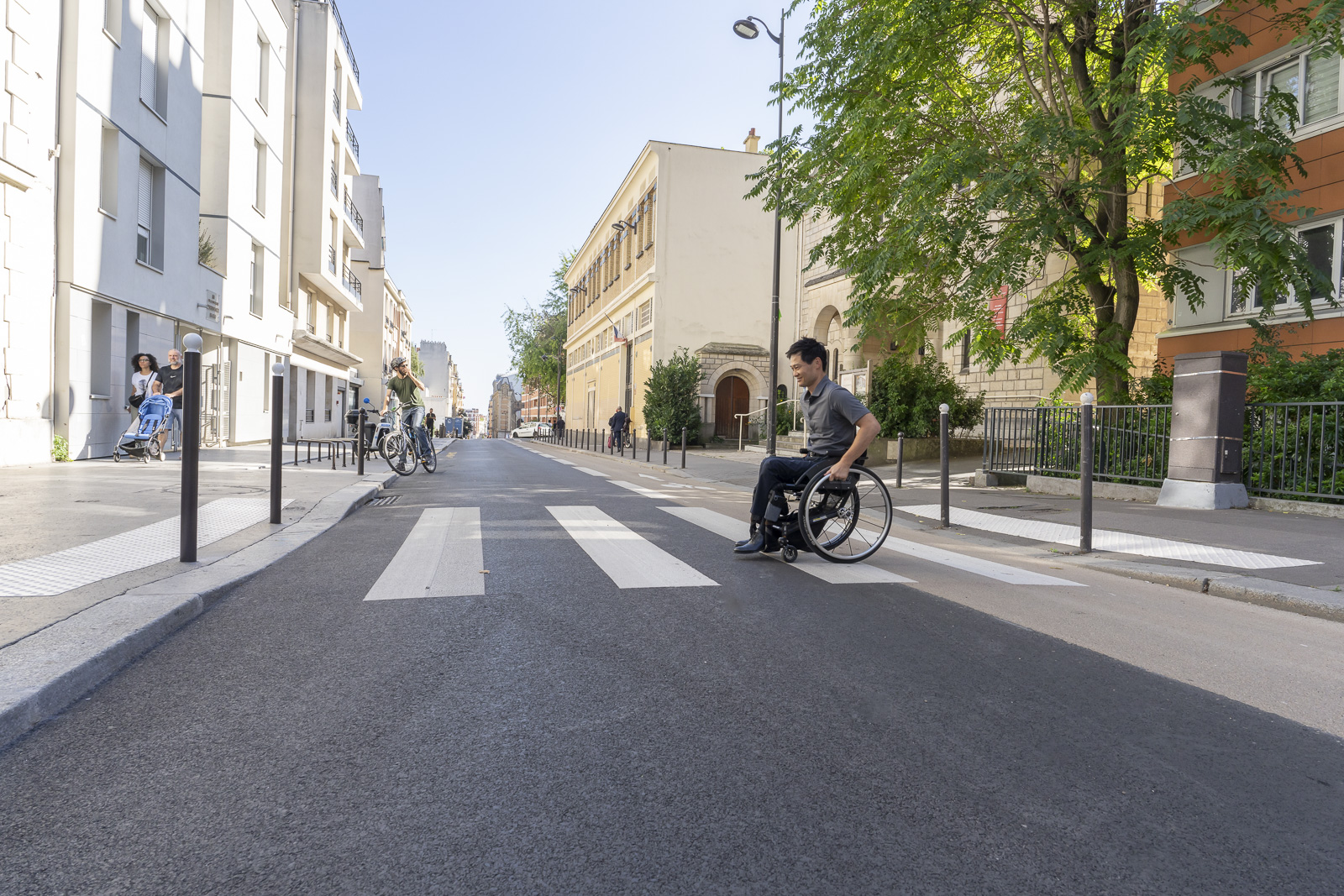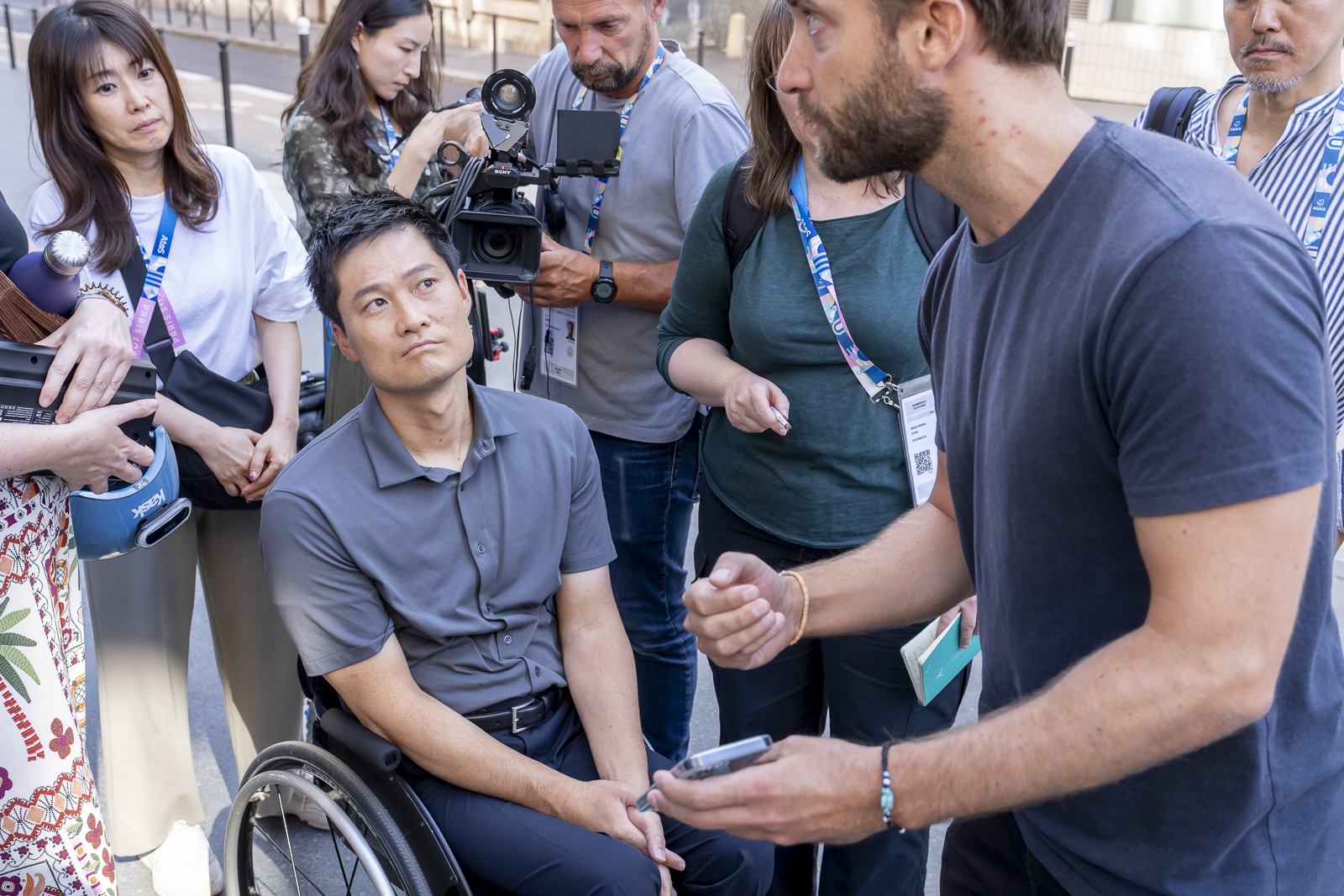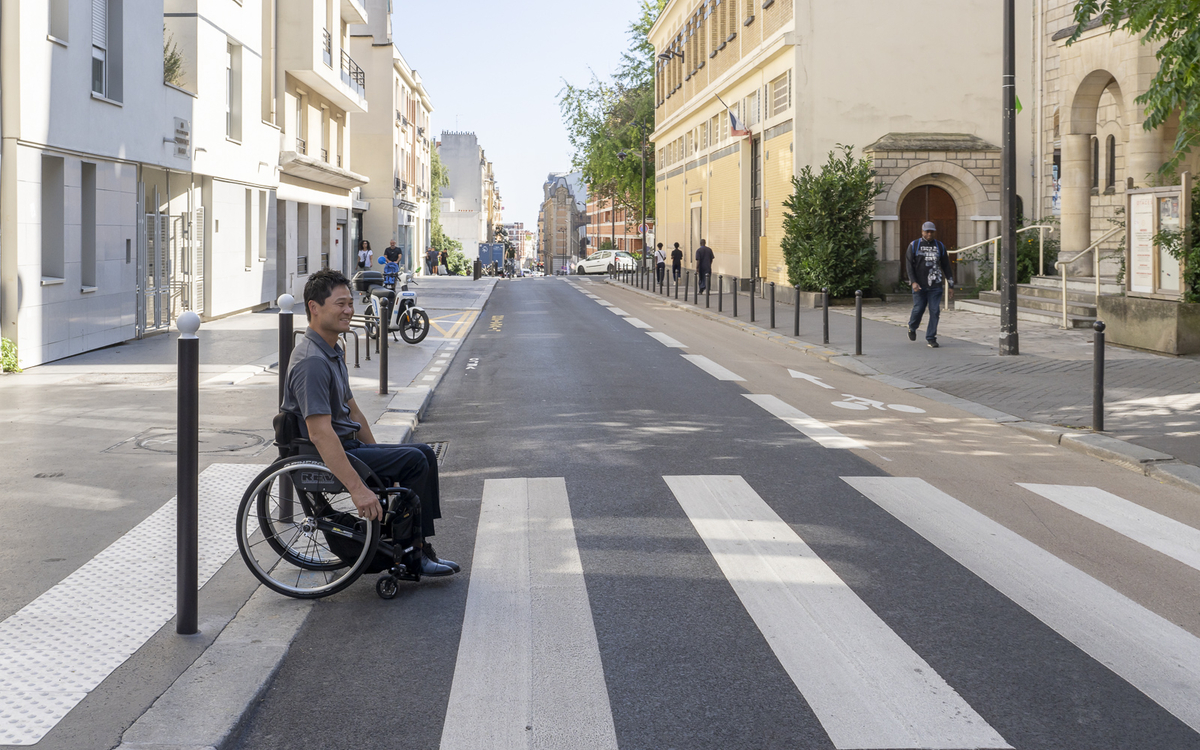Content
Cette page est aussi disponible en français
We took advantage of the Paralympic Games to "test run" one of the capital's new enhanced accessibility neighborhoods. We met Japanese wheelchair tennis legend Shingo Kunieda at the Saint-Fargeau metro station (20th arrondissement).
Is it really possible to use a wheelchair to get around the steep, winding streets of Paris? Is it really possible to access municipal services when you're disabled? This is the challenge embraced by the capital's 17 enhanced accessibility neighborhoods: to be exemplary areas that allow everyone, regardless of their circumstances, to navigate with ease.
These developments, which have been underway for several years in each arrondissement, have been accelerated during the hosting of the Paris 2024 Games. They are also part of the Olympic and Paralympic Games legacy : the transformations and experiments will benefit Parisians in the long term.
Crossing the road thanks to a remote

The universal remote control for the visually impaired
Crédit photo :
Clément Dorval / Ville de Paris

Crédit photo :
Clément Dorval / Ville de Paris

Crédit photo :
Clément Dorval / Ville de Paris
In the Saint-Fargeau neighborhood (20th arrondissement), the latest works were completed last July. Wheelchair tennis legend Shingo Kunieda wanted to test the course during his stay in the City of Light. At 39, the multi-medal-winning Japanese athlete is now retired, but was sent to Paris as a pundit for the Japanese public broadcaster NHK for the Paralympic Games.
Its route starts at the top of avenue Gambetta (20th arrondissement), at an altitude of 108 m. Addressing the accessibility of steeply sloping streets presents a unique challenge that has engaged multiple departments within the city. Can the first zebra crossing be crossed safely? Yes, the white tactile paving strips have been renewed to ensure the safety of the visually impaired, and the city distributes free universal remote controls that trigger sound.
When the pedestrian light turns green, a sound is emitted; when it's red, a voice indicates as such. Of the 22,000 pedestrian crossings in Paris, more than half are equipped with these sound modules, with over 1,200 installed in the enhanced accessibility neighborhood. For the Paris 2024 Games, 1,000 additional remote controls have been distributed to visitors, and English versions have also been developed.
Taking the bus: mission accomplished
Head for bus stop 61/64/96. It's one of 1,750 stops that have been made accessible. The sidewalk has been raised to allow buses to deploy their ramps. At the Saint-Fargeau stop, an offset platform has been installed, the cycle path raised and a grooved guidance system installed on the ground for the visually impaired. For the moment, the 20th arrondissement is the only one trailing this system.
Another major project carried out on the avenue was to clear it of clutter. Wherever possible, obsolete objects and obstacles have been removed from the public space. Any anomaly can be reported in just a few clicks using the DansMaRue application.
Walking on sidewalks!
Shingo Kunieda then took rue Haxo (20th). Over the course of four months, the kilometer-long street has undergone a number of modifications to improve access for the disabled. Previously, it would have been very difficult for the para-athlete to walk on the narrow sidewalk.
Not only has the sidewalk been extended along the entire length of the street, but City services have also worked on the slope to make it straighter and more pleasant to walk on. The result: over 1,000 additional square meters for pedestrians!

Rue Henri-Dubouillon (20th arrondissement) has been partially pedestrianized.
Crédit photo :
Clément Dorval / Ville de Paris
Work was also carried out on traffic flow to calm the street. A bicycle lane separates pedestrian-bicycle-vehicle flows more effectively and makes the road safer for each type of mobility. A project carried out hand in hand with associations specializing in helping the disabled.
Finally, in front of each crossing, bollards have been placed higher than the others. Some 50 warning strips have also been installed.

The StreetNav appli
Crédit photo :
Clément Dorval / Ville de Paris

Demonstration of the StreetNav app to wheelchair tennis champion Shingo Kunieda
Crédit photo :
Clément Dorval / Ville de Paris
Parking, finding your way around… thanks to the StreetNav application
Rue Henri-Dubouillon (20th arrondissement) has also undergone a face lift in recent months. It has been possible to create an adapted disabled parking space. This is no mean feat in some of the capital's narrow streets. The StreetNav application was introduced to the former tennis ace.
The N-Vibe app, supported by the Résidence de l'Accessibilité du 20e, is a collaborative platform often described as "Google Maps for disabled people." It empowers them to independently modify their routes in real time in response to any obstacles they encounter. It is being tested in some twenty cities in France and in seven enhanced accessibility neighborhoods in Paris.
Are there adapted school streets in Japan? In Paris, there are already 218, including rue des Tourelles (20th arrondissement). Adjacent to the elementary school, the street has been converted to a pedestrian zone to ensure a safer path for children traveling between home and school, as well as to reduce pollution. Concurrently, these enhancements also aid individuals with limited mobility.

Rue des Tourelles (20th arrondissement): before and after the transformation of this highly accessible district
Crédit photo :
Clément Dorval / Ville de Paris
Access to public facilities are possible!
Within each enhanced accessibility neighborhood, a priority route has been defined, allowing access to a range of accessible public services. On each of these routes there are at least eight buildings covering eight service categories (sports, health, cultural, early childhood, school and leisure facilities, libraries and green spaces).
This walk is an opportunity to stop in front of the Tourelles Gambetta day nursery. The crèche is equipped with an elevator, accessible toilets and all the facilities needed to accommodate families with disabilities. Awareness-raising sessions on accessibility and disability were offered to all staff at municipal facilities in hyper-accessible neighborhoods, with role-playing exercises, in particular using a virtual reality headset.

With the August heat, Shingo Kunieda is envious of the pool's water and sunroof.
Crédit photo :
Clément Dorval / Ville de Paris
Would you like to end this tour with a swim in the clear waters of the Georges-Vallerey swimming pool (20th arrondissement)? The building on avenue Gambetta impressed the Japanese delegation. Who would have thought that a facility built for the 1924 Olympic Games could be made accessible? And yet, after two years of redevelopment work, the pool was ready to welcome athletes for training during the Paris 2024 Games.
Among the innovations at the heart of its metamorphosis: enhanced accessibility, with an accessible pathway from the entrance to the pool. The reception desk has been adapted for wheelchair users, and another new feature is the creation of a room for guide dogs at the entrance to the pool - a first for a sports venue in the capital!
Even with the success of this new type of neighborhood, expectations must still be tempered. There is still much work to be done to guarantee that individuals with disabilities have access to a completely accessible public space. In an old European city, challenges still endure, but the direction is clair, and early improvements are encouraging.
Default Confirmation Text
Settings Text Html
Settings Text Html
We want to hear from you!
Was this information useful to you?
Please note: we cannot reply via this form (please do not include any personal information).
